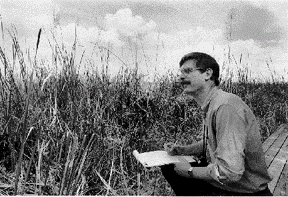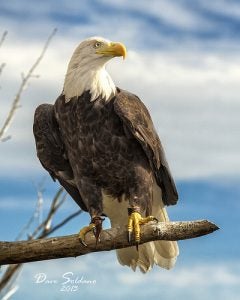
Michael Bean is a prominent wildlife conservation expert and attorney. He is also the author of The Evolution of National Wildlife Law, a leading text on wildlife conservation law. Many consider Bean “the dean of endangered species protection.”
Few people know more about wildlife conservation in America than Michael Bean. A renowned expert in wildlife policy and programs, Michael is hailed as an innovative thinker who has consistently found effective ways to protect our nation’s endangered species, pioneering techniques like Safe Harbor agreements and Habitat Conservation Plans that have helped many animals at risk of extinction.
Michael started working at EDF in 1977 where he directed our wildlife conservation policy initiatives for several decades, during which I came on board and had the honor of working closely with him. In 2009, Michael went on to join the U.S. Department of the Interior as counselor to the Assistant Secretary for Fish, Wildlife and Parks, and later as the Principal Deputy Assistant Secretary.
Today, we are fortunate to have Michael back as an advisor to EDF, and to have him share his insights on the current state of our country’s wildlife programs and policies.
What drove you to dedicate your career to wildlife law, and specifically, endangered species?
Growing up in a Mississippi River town in Iowa, I spent a lot of time outdoors catching snakes, frogs and turtles, and playing in the creek behind my house. I developed a real fondness for nature and wildlife from an early age. At the time that I joined EDF, endangered species struck me as the most important and serious environmental issue for a very simple reason: once species are lost, they’re gone forever. There’s no turning back the clock. There’s no bringing them back.
So, when it came time for me to choose which career to pursue, I looked for something that combined my personal interests in conservation and wildlife protection with my legal training. EDF offered me the opportunity to be both a lawyer and a conservationist.
What would our ecosystems look like without the Endangered Species Act (ESA)?
Well, we clearly wouldn’t have some of the keystone species that have great influence on other wildlife and broader ecosystems. The reintroduction of wolves into Yellowstone has had dramatic and profound effects on that ecosystem – elk foraging behavior has changed, and, as a result, key vegetation such as willow is flourishing and beaver populations are thriving. Sea otters have influenced the growth of kelp forests and the lively biodiversity that we associate with the California coast. In the Great Plains, black-footed ferrets have helped control prairie dog populations. These are just a few examples of species that are still around and contributing valuable ecosystem services, despite facing almost certain extinction, thanks to the ESA.
Every community has benefited from the ESA because all of us benefit from biological diversity – economically, recreationally, aesthetically and spiritually.
How do you see the ESA being improved, or reformed, if at all?
The absence of positive incentives to engage private landowners as partners in conservation is a critical need. The ESA itself is currently focused on prohibiting harmful conduct, which is certainly important. However, we need to focus on not just keeping things from getting worse, but also actively making things better. And that comes from encouraging positive behaviors to benefit endangered species. The key need here is involving private landowners.
Most, if not all farmers and ranchers want to be good stewards of their land, and most enjoy the presence of wildlife on their land. But there are regulatory consequences and costs that may discourage implementation of species conservation measures – and anyone who wishes to improve the law’s results should start by addressing these needs through positive incentives.

Michael Bean examined the new role of NGOs in species conservation in his 2001 article Safe Harbor Agreements: Carving Out A New Role for NGOs. Safe Harbor agreements were innovative voluntary agreements between private landowners and the U.S. Fish and Wildlife Service to promote endangered species protection.
What are some species that you worked on throughout your career that stand out to you as examples of what works and what does not?
I am particularly proud of the success of Safe Harbor agreements with red-cockaded woodpeckers. These birds occur in ten states in the Southeast, but much of their habitat is on private land. In the late 90s, many landowners were unwilling to manage their land as habitat for the red-cockaded woodpecker. Through our work at EDF, we experimented with Safe Harbor agreements, which encouraged landowners to implement beneficial practices that conserved habitat for the birds and helped to recover populations. Today, there are 2.5 million acres of land on which private landowners are laying out a welcome mat for this endangered bird and there are over 100 new family groups of this endangered species on these Safe Harbor properties.
What are the biggest challenges of creating and maintaining successful wildlife legislation?
The biggest challenge facing wildlife legislation is polarization around environmental issues. It’s easy to forget that when the ESA was passed in 1973, it was passed unanimously in the Senate and almost unanimously in the House. A lot of our cornerstone environmental laws were passed in the late 60s and early 70s – the Clean Water Act, the Clean Air Act, and the National Environmental Policy Act, to name a few. There was bipartisan recognition at that time that the environment was in need of attention and there was bipartisan support to address these threats.
Hyper-partisanship has affected not just wildlife legislation, but environmental legislation in general.
Today, it is hard to imagine any environmental legislation getting close to that level of support. Environmental issues have become highly partisan. Even the science underlying the issues is being disputed by some skeptics. This hyper-partisanship has affected not just wildlife legislation, but environmental legislation in general.

When it was first published in 1977, Michael’s book was the only publication to “analyze wildlife law comprehensively as a distinct component of federal environmental law.” The second edition was published in 1983 and the third in 1997 (with coauthor Melanie Rowland). The book remains a standard reference for those seeking to understand wildlife law.
How has federal environmental law and wildlife law changed since the first publication of your book, The Evolution of National Wildlife Law, in 1977?
There is a lot more contention and litigation of late than there was in the earlier years. In part, that’s due to partisanship, but it’s also due to other factors as well. The laws that were passed in the 60s and 70s are in the same basic form today that they were in when they were passed. They have withstood the test of time, but the implementation of those laws has become more contentious. You see that in efforts by both the current administrator of the EPA and the secretary of the Interior, who have both worked to roll back the initiatives of the previous administration. This has never happened on this sort of scale in the past, and it’s disconcerting.
What communities are most affected by the ESA? Are there opportunities to improve the way the law works for people, the economy and the environment?
Every community has benefited from the ESA because all of us benefit from biological diversity – economically, recreationally, aesthetically and spiritually. We can now see our national symbol, the bald eagle, soaring in the wild as one of many species that are no longer endangered. That is a profound benefit to all Americans.
Some communities have been affected more than others, but there are opportunities for the ranching and forestry communities in particular to find ways to compatibly manage their lands for economic purposes and help imperiled wildlife at the same time. This was seen with red-cockaded woodpeckers and it’s happening now as we see ranchers working to prevent the greater sage-grouse from becoming endangered.
With a serious effort to look for compatibility, we will see it’s possible to share spaces with rare species and still meet human needs.

The bald eagle was first listed as endangered in 1963. Due to conservation efforts led by EDF, it was successfully recovered and delisted by 2007, with an estimated 10,000 mating pairs in the wild. (Photo Credit: Dave Soldano.)
Related:
What we’ve learned from 50 years of wildlife conservation >>
Let’s make ESA listings extinct, not wildlife >>
We need to get creative to protect wildlife in the face of climate risk >>









